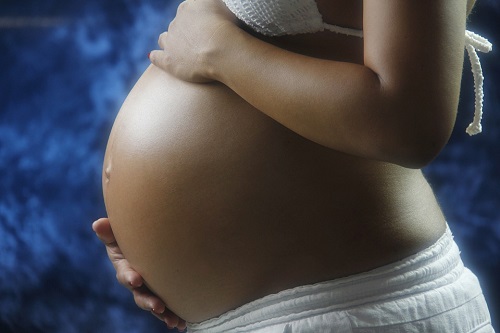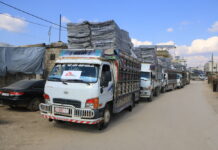On Monday, almost a week after the brutal murder of Karabo Mokoena  sent South Africa into a tailspin, sparking rage on social media under the hashtag MenAreTrash, Statistics South Africa (StatsSA) released its 2016 Demographic and Health Survey (DHS).
The survey, conducted by Stats SA and the South African Medical Research Council on behalf of the National Department of Health, collected data from respondents in 11 083 households between June and November last year. It provides much-needed information on gender-based violence, particularly given the lack of detail in police statistics on domestic violence. But also, there are a bunch of other important findings regarding the health and wellbeing of women. The Daily Vox rounds up eight of the most significant finds from the survey.
1. Physical violence is prevalent AF
Here’s a shocker: Karabo Mokoena’s case is not an anomaly. One in 5 South African women older than 18 have experienced physical violence by a partner. The survey shows that 10% of younger women aged 18 to 24 faced this in the 12 months before the survey. Separated and divorced women were also more likely to experience physical violence (40%), followed by those living with a partner (31.1%).
And as if poverty isn’t enough of a challenge, the survey also found that women in the poorest households were more likely to experience physical violence (24.4%). Wealthy women weren’t exactly safe either – 13% of those who experienced physical violence came from the top-earning homes.
The North West had the highest levels of intimate partner violence (5%) and the Western Cape and Limpopo had the lowest levels (1%). Good news, women of Limpopo and the Western Cape! It looks like you’re less likely to experience intimate partner violence than your sisters in other provinces.
2. The older you are, the more likely you are to experience sexual violence
The DHS shows that overall, 6% of women older than 18 experienced sexual violence by a partner. But the numbers were worse the older women got. According to age, 5.2% of young women aged 18 to 24 experienced sexual violence, 7% of women aged 25 to 34 and 7.1% of women aged 55 to 64 experienced sexual violence.
Yep, proof that men are still trash.
3. Young men are more likely to have more partners than young women
Young men are more likely to have sexual relations with multiple partners than young women. The survey says 4.2% of young women aged 15 to 24 reported having more than two sexual partners in the year before the survey, compared to the 20.7% of young men in the same age group.
We knew this too but it’s good to know we have the data to back us up.
4. Younger people are less likely to have tested for HIV/Aids
Despite the fact that 6.2 million South Africans or 11.2% of the population were living with HIV in 2015, the survey found that 32% of women and 42% of men between the ages of 15-24 have never been tested for HIV/Aids.
The numbers are not necessarily reflective of access to information as 92% of women and 93% of men knew where to get tested. This means people probably have negative attitudes towards testing.
I thought we all agreed that it’s important to know your status?
32% of women and 42% of men aged 15 – 24 years old have never tested for #HIV #SADHS #Healthhttps://t.co/uKaM5P1m74 pic.twitter.com/nSORm1D8r9
— Stats SA (@StatsSA) May 15, 2017
5. Risky sex is still a thing
Worryingly, Â only 58% of women and 65% of men who had multiple partners in the past year reported using a condom during their last sexual intercourse.
Honestly, there should be a higher percentage of condom usage in both men and women, especially since Cyril Ramaphosa introduced the government-sponsored flavoured condoms last year.
6. Many girls fall pregnant in primary school
In the survey, 28% percent of girls below the age of 19 were reported to have been pregnant. What’s quite alarming is that a third of those girls had not completed primary school yet.
Teen pregnancies were also shown to be more likely in non-urban areas, with 86 per 1,000 live births, compared to the 62 per 1,000 live births in urban areas.
By 19 years of age 28% of girls have begun childbearing, a third of these births are to girls who have not completed primary school #SADHS pic.twitter.com/SzWZ9jVBfG
— Stats SA (@StatsSA) May 15, 2017
7. Still, teen pregnancy isn’t increasing.
Both Statistician General Dr Pali Lehohla and Motsoaledi debunked the misconception that social grants encourage young girls to have children. Motsoaledi said most young girls only register for social grants two years after their child is born. Teens are clearly getting pregnant because they don’t use condoms reliably. (See point 5, above.)
Adolescent pregnancies can trap girls into a lifelong battle against poverty, and we need to get better at delivering youth-friendly sexuality education and reproductive healthcare. But there’s no need for more moral panic – the teen pregnancy rate has barely changed 1998.
8. And actually, the birth rate is decreasing
The survey shows that South Africa is approaching what Motsoaledi called a “demographic winter“. This is just a fancy term that means women are giving birth to fewer children. The average number of children born per woman was 2.6 in the last three years – down from 2.9 over the three-year period ending in 1998.









